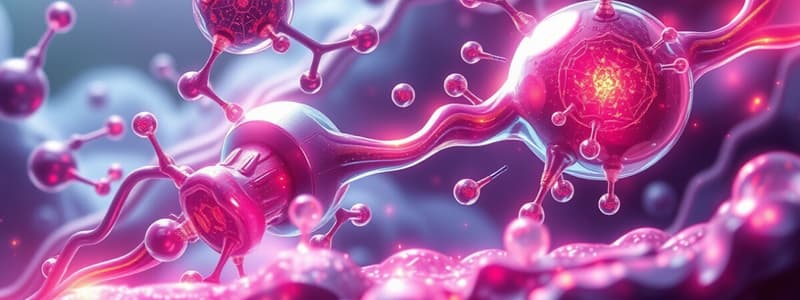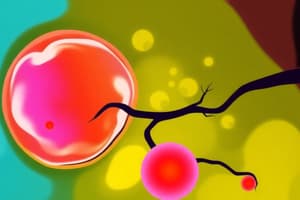Podcast
Questions and Answers
Which nitrogenous bases are classified as purines?
Which nitrogenous bases are classified as purines?
- Thymine and Cytosine
- Adenine and Guanine (correct)
- Cytosine and Uracil
- Uracil and Thymine
What is the role of the phosphate group in nucleotides?
What is the role of the phosphate group in nucleotides?
- Providing energy through ATP (correct)
- Encoding genetic information
- Acting as a nitrogen source
- Forming the structure of proteins
Which statement best describes the process of nucleophilic substitution?
Which statement best describes the process of nucleophilic substitution?
- A leaving group must be present to facilitate the substitution. (correct)
- Nucleophiles are typically cations or electron-poor species.
- An electron-withdrawing group improves nucleophilicity.
- It involves only neutral atoms without charges.
Which nitrogenous base is NOT part of RNA?
Which nitrogenous base is NOT part of RNA?
What are the primary components of a nucleotide?
What are the primary components of a nucleotide?
What is the primary function of nucleotides in biological systems?
What is the primary function of nucleotides in biological systems?
Which of the following correctly describes the difference between aldose and ketose sugars?
Which of the following correctly describes the difference between aldose and ketose sugars?
Which statement accurately reflects the role of amino acids in protein synthesis?
Which statement accurately reflects the role of amino acids in protein synthesis?
What defines a short polypeptide in terms of amino acid quantity?
What defines a short polypeptide in terms of amino acid quantity?
Which of the following is NOT a type of polysaccharide?
Which of the following is NOT a type of polysaccharide?
Which compound is a nucleotide that has a special biological function?
Which compound is a nucleotide that has a special biological function?
What are the primary building blocks of nucleic acids?
What are the primary building blocks of nucleic acids?
What is the significance of polymerization in biological macromolecules?
What is the significance of polymerization in biological macromolecules?
What is the primary function of Deoxyribonucleic Acid (DNA)?
What is the primary function of Deoxyribonucleic Acid (DNA)?
Which type of RNA is primarily involved in protein synthesis?
Which type of RNA is primarily involved in protein synthesis?
What role do phospholipids play in cellular biology?
What role do phospholipids play in cellular biology?
What term describes the sum of all enzyme-catalyzed reactions in a living organism?
What term describes the sum of all enzyme-catalyzed reactions in a living organism?
Which component is NOT part of nucleotides?
Which component is NOT part of nucleotides?
Which of the following best describes anabolism?
Which of the following best describes anabolism?
Which of the following is an example of a fat-soluble vitamin?
Which of the following is an example of a fat-soluble vitamin?
Which lipid plays a critical role in the composition of animal cell membranes?
Which lipid plays a critical role in the composition of animal cell membranes?
Flashcards are hidden until you start studying
Study Notes
Molecule Synthesis and Biological Functions
- Molecules are essential for cell structure, growth, development, and waste removal.
- Phosphate groups play a critical role in various biochemical functions.
- Nitrogenous bases are vital components of nucleic acids.
Classes of Bases
- Purines: Adenine (A) and Guanine (G).
- Pyrimidines: Thymine (T), Cytosine (C), and Uracil (U).
Nitrogenous Bases
- DNA contains purines and pyrimidines, forming a double-ring structure.
- Functions of DNA:
- Contains and stores genetic information.
- RNA primarily expresses this genetic information during protein synthesis.
Role of Nucleotides
- Adenosine triphosphate (ATP) is a key nucleotide involved in energy transfer and biosynthesis.
Phospholipids
- Major component of cell membranes, featuring hydrophilic heads and hydrophobic tails.
Examples of Lipids
- Steroids: Cholesterol, crucial for animal cell membranes and acts as a sex hormone.
- Fat-soluble vitamins: Vitamin E and Vitamin A.
- Carotenoids: Plant pigments aiding in photosynthesis, characterized by orange, bright red, and yellow colors.
Biochemical Reactions
- Metabolism encompasses all enzyme-catalyzed reactions in an organism, divided into:
- Anabolism: Building larger molecules from smaller ones, utilizing ATP.
- Catabolism: Breaking down larger molecules into smaller ones (e.g., glycolysis).
Nucleotides Structure
- Composed of three main components:
- 5-carbon sugar.
- Phosphate group.
- Nitrogenous base.
Functions of Monosaccharides
- Monosaccharides can act as simple sugars and can be categorized by their functional groups:
- Polyhydroxyl Aldehyde (Aldose).
- Polyhydroxyl Ketone (Ketose).
Common Monosaccharides
- Glucose: Combines with glucose to form maltose.
- Fructose: Combines with glucose to form sucrose.
- Ribose: A component of RNA.
- Deoxyribose: A component of DNA.
Polysaccharides
- Polysaccharides are large polymers formed by many monosaccharides.
- Examples include:
- Glycogen: Energy storage molecule in animals.
- Starch: Energy storage molecule in plants.
Amino Acids
- 20 common α-amino acids are the building blocks of proteins.
- The chemical properties of amino acids are largely determined by their side chains (R groups).
- Polymerization leads to the formation of short polypeptides (less than 50 amino acids, termed peptides).
Studying That Suits You
Use AI to generate personalized quizzes and flashcards to suit your learning preferences.




